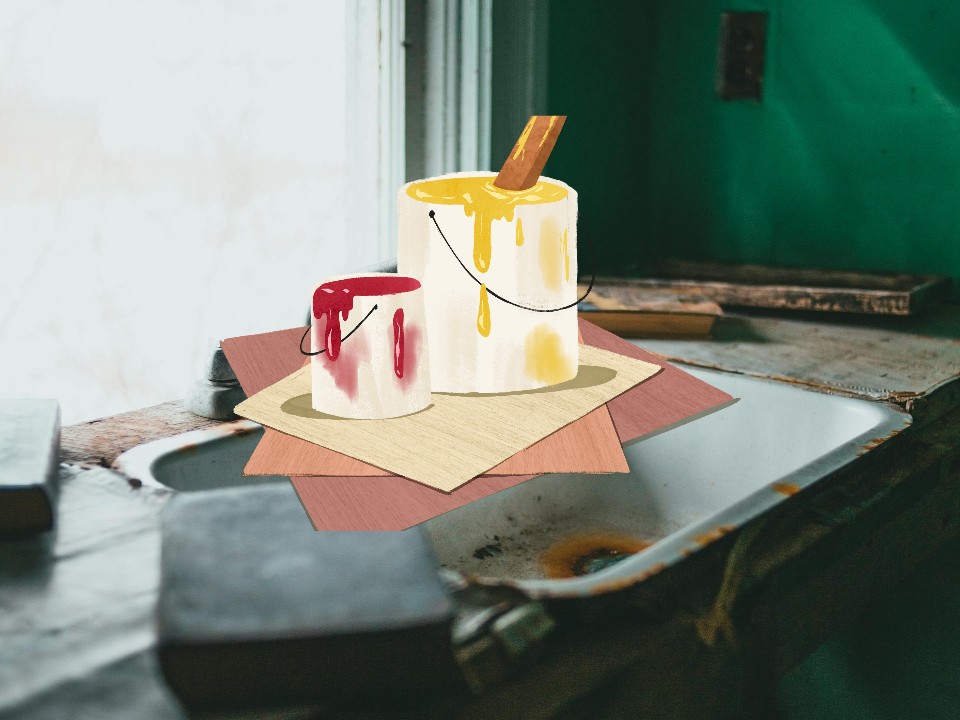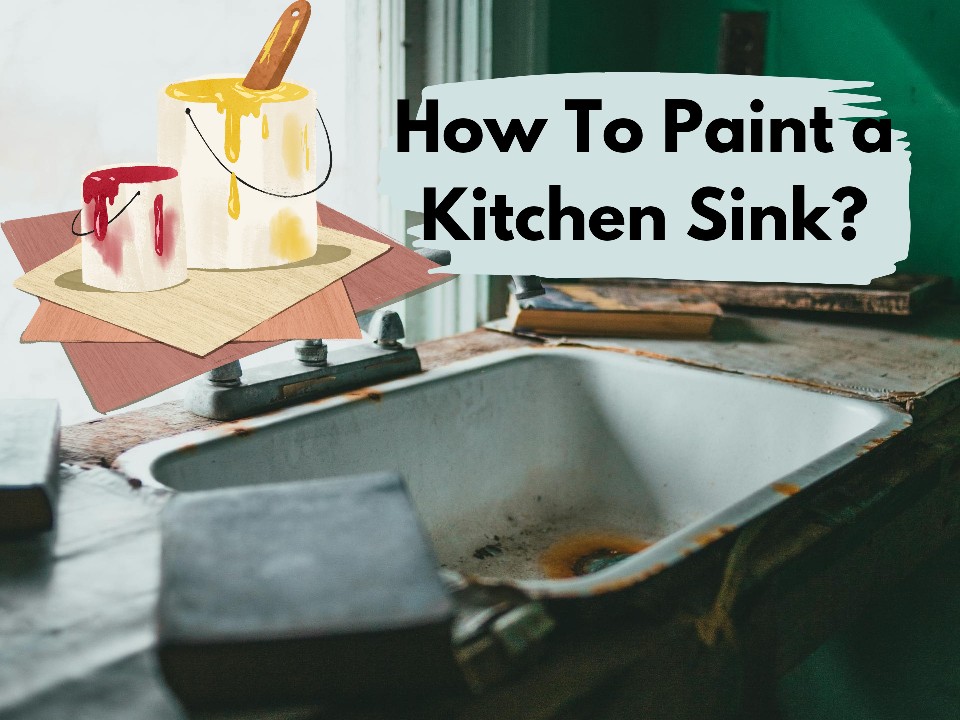Can you paint a kitchen sink? Absolutely! If you’re looking to breathe new life into your tired sink without breaking the bank, painting can be a game-changer.
Whether it’s to match a new color scheme, hide stubborn stains, or just for a fresh look, giving your sink a makeover is a fun DIY project that many homeowners have tackled with great success.
But before you grab that paintbrush, there are some important things to consider. From the types of sinks that can be painted to the best materials and techniques, I will discuss everything you need to know to achieve a professional finish.

Is It Possible to Paint a Kitchen Sink: Types of Kitchen Sink You Can Paint
Yes! You can paint a kitchen sink whether you want to match its aesthetics with the kitchen decor or want to get a new look. However, you need to consider the type of sink to understand if it is more or less suitable for painting.
Here are the common types of kitchen sinks you can paint:
- Porcelain and Cast Iron Sinks: These types of sinks are best for painting. You can pick the right epoxy-based or specialty paint designed for high-heat and high-moisture environments to get the best results.
- Stainless Steel Sinks: While it’s possible to paint stainless steel, the paint may not adhere as well. The finish will likely wear off faster due to constant use. Special preparation and the right primer can help improve durability.
- Acrylic and Composite Sinks: These materials can be more challenging to paint since they might not hold the paint well. Choosing a suitable primer and paint specifically made for plastic surfaces is crucial.
- Granite and Stone Sinks: It’s generally not recommended to paint these types because the surface is often porous and can make it difficult for paint to adhere properly.
The key to success lies in proper preparation, choosing the right paint, and being aware of the limitations based on the sink’s material.
Can You Paint A Kitchen Sink by Yourself?
Absolutely, you can paint a kitchen sink by yourself, but it’s not a quick splash of paint and done! Painting a sink is one of those DIY projects that sounds straightforward but does take some patience, prep work, and just the right materials to look like a professional job.
Here’s a quick step by step DIY guide on painting a kitchen sink:
Step 1: Cleaning & Sanding
Your sink needs to be squeaky clean, like a shiny new penny, so the paint will stick. You’ll want to scrub it down with a degreaser, then lightly sand it to give the paint a bit of grip.
Step 2: Masking Off
Cover up everything you don’t want painted. Trust me, paint on your faucet or countertop will not look cute. Grab some painter’s tape and maybe some plastic sheeting to protect nearby areas.
Step 3: Ventilation
You’ll need good airflow, since most of these paints give off some pretty strong fumes. Open the windows, turn on the fan, and maybe even wear a mask.
Step 4: Applying Paint
With the prep done, you can start applying the paint in thin, even layers. Multiple coats are key! You’ll want each coat to dry before adding the next to avoid drips and ensure a smooth finish.
Step 5: Drying Time
Here’s where patience really kicks in. Give the paint plenty of time to fully cure – typically a day or two, sometimes longer. It might feel dry to the touch in a few hours, but the real durability comes from letting it cure fully.
While painting a sink by yourself is definitely possible, a bit of prep and patience will make the difference between a “wow” transformation and a DIY that looks… Well, a little too DIY!
What Types of Paints to Use On A Kitchen Sink?
Choosing the right paint for your kitchen sink is crucial, as this isn’t a surface that gets off easy. Sinks see everything from hot water to heavy pans, so your paint has to be as tough as a two-dollar steak!
Here’s the types of paints that can handle the job:
1. Epoxy Paint
This is the gold standard for sinks. Epoxy paint is a heavy-duty, waterproof paint that bonds like superglue to non-porous surfaces like metal, ceramic, or porcelain. It’s also highly resistant to chipping and scratches, which is why it’s often used for tubs, sinks, and other surfaces that get regular use.
2. Appliance Epoxy Spray Paint
Appliance epoxy spray paint is another go-to for a DIY sink facelift. It’s specially made for the metal surfaces found on appliances like refrigerators, washers, and yes, even sinks. This spray paint goes on smooth and can be easier to apply evenly, especially on a curved surface like a sink basin.
3. Oil-Based Paint with a Waterproof Sealer
If kitchen sink epoxy paints aren’t an option, a good-quality oil-based paint can also work, but you’ll need to seal it afterward to protect it from water damage. Oil-based paints offer strong adhesion and durability, but they can yellow over time if not protected.
4. Rust-Oleum or Specialty Sink Paint Kits
Some brands make specific products just for sinks and tubs – Rust-Oleum’s Tub and Tile Refinishing Kit is a popular one. These kits are made to stand up to high-moisture areas and come with everything you need to paint your sink like a pro.
What Not to Use
Steer clear of regular latex or acrylic paints—they might look fine at first, but one splash too many, and you’ll be dealing with a peeling mess. These paints simply aren’t built for the humid, high-traffic world of the kitchen sink.
So, when it comes down to it, epoxy-based paints and specialty kits are your best bet for durability and a long-lasting, chip-free finish. They’re tough enough to handle daily use and still look great, so your sink’s new look isn’t just a flash in the pan!
Benefits of Painting A Kitchen Sink
Painting a kitchen sink might seem like a bold move, but it’s actually a fantastic DIY hack with a lot of benefits. If you’re looking to give your kitchen a fresh look without tearing out your old sink, paint can work wonders.
Here’s why painting a sink is worth considering:
- Saves Money – Painting a sink costs far less than replacing it, letting you revamp your kitchen on a budget.
- Custom Colors – Painting opens up endless color options beyond the usual whites and metals. You can go bold, bright, or classy to match your kitchen vibe.
- Extends Sink Life – Covering chips and stains with paint makes your sink look almost new. A durable paint layer adds years to your sink’s life.
- Quick Refresh – It’s a small, impactful upgrade that changes the look of your whole kitchen. No need for a full remodel when a simple paint job does the trick.
- Eco-Friendly – Repainting lets you reuse a perfectly good sink, reducing waste. It’s a green choice that’s both stylish and sustainable.
- Boosts Home Value – A well-maintained, attractive sink catches buyers’ eyes and adds to kitchen appeal. It’s a small touch with real impact on home value.
Disadvantages of Painting A Kitchen Sink
Painting a kitchen sink has its perks, but it’s not without a few downsides to consider.
- Less Durability – Even with high-quality kitchen sink epoxy paint, a painted sink won’t last as long as a new one. Over time, the paint may chip or wear, especially in high-use areas.
- Maintenance Required – A painted sink needs gentle cleaning to avoid scratches or chips. Using harsh chemicals or scrubbing too hard can shorten its lifespan.
- Inconsistent Finish – Achieving a smooth, professional finish takes skill and patience. DIY painting can sometimes lead to uneven coats or drips if not applied carefully.
These drawbacks don’t make painting a sink impossible, but they’re worth weighing before you dive into the project!
Secret Tips for Painting A Kitchen Sink
Here are some top tips to ensure your kitchen sink painting project turns out beautifully:
- Prep Like a Pro – Cleaning and sanding are essential. A thorough degreasing and light sanding will help the paint stick much better and last longer.
- Use Thin, Even Coats – Apply multiple thin layers rather than one thick coat. Thin coats dry more evenly, preventing drips and ensuring a smooth, professional finish.
- Allow Extra Drying Time – Give each layer of paint plenty of time to dry completely before applying the next. This helps avoid bubbling or peeling and gives you a more durable finish.
- Ventilation is Key – Open windows and doors or use a fan while painting to keep fumes at bay. Proper ventilation will make the job more comfortable and safer.
- Avoid Heavy Use at First – After painting, give the sink at least a week to fully cure before heavy use. This extra curing time strengthens the finish, making it more durable in the long run.
Use some good quality kitchen sink paint kit to get the best results. These small steps can make all the difference, leaving your sink looking like it was professionally refinished!
Paint And Transform Your Kitchen Sink Today!
Painting your kitchen sink is a budget-friendly, high-impact way to give your kitchen a fresh, updated look. With the right prep, paint, and a little patience, you can transform a dull, worn sink into a standout feature that matches your style.
Sure, it takes some effort, but the payoff? A sink that looks brand new without the new-sink price tag! So grab that paintbrush, follow the tips, and get ready to wow yourself (and everyone else) with a DIY sink transformation that’s as durable as it is stunning. Happy painting!
FAQs:
Can you paint a stainless steel kitchen sink?
Yes, you can paint a stainless steel kitchen sink, but it requires careful preparation to ensure proper adhesion. Using a high-quality primer specifically designed for metal surfaces is essential, along with an epoxy or specialty paint.
How long does the paint stay on a kitchen sink?
The longevity of the paint on a kitchen sink varies depending on the type of paint used and how well the surface is prepared. Typically, with proper application and care, you can expect the paint to last anywhere from a few years to several years.
Is it safe to paint a kitchen sink?
Yes, it is generally safe to paint a kitchen sink, provided you use non-toxic, water-based paints or those specifically designed for kitchen use. Always ensure proper ventilation while painting and allow the paint to cure completely before using the sink to avoid any potential issues.
Is painting a kitchen sink worth it?
Painting a kitchen sink can be a worthwhile investment if you’re looking for a cost-effective way to refresh your kitchen’s appearance. It allows for customization and can extend the life of an older sink.
